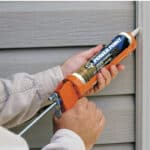
Over the past fifteen years, new trends and innovations have radically impacted the decking world. Hidden fasteners allow for decks that look unmarred and perfect. Composite decking creates decks that will last a lifetime. And at the same time, underneath the deck boards, a quiet innovation has started taking root to protect the substructure of decks.
Deck Flash Barrier, Joist Tape, or Deck Tape. Whatever you call it, it means the same thing. A self-adhesive tape gets installed over the crown of the deck joists, which self-seals around screws and fasteners, keeping moisture out of the core of the lumber. This step is important for several reasons. The number one cause of deck failure is wood rot. By preventing moisture from entering the core of the lumber in the first place, deck flashing stops wood rot before it can begin. This also prevents water from breaking down the lumber via the freeze-thaw cycle in parts of the country that get below freezing.
There are many different adhesive types, but deck flashing primarily comes in two versions. Rubberized asphalt is the original Deck Flash Barrier adhesive. It is a time-tested old-school adhesive. It works great at adhering to lumber and sealing out moisture, but it must be applied at around 50 degrees or higher. Butyl rubber adhesives have solved this problem and are now common in the industry. These butyl deck flashings can be installed at lower temperatures, usually down to about 25oF or warmer. Some manufacturers have recently even started introducing acrylic adhesive products to the deck flashing market. Regardless of the adhesive type, when properly installed, deck flashing will stay adhered in most weather conditions.
While using flashing on deck joists helps extend the life of every new deck, it’s absolutely essential on a re-deck. When re-decking, not only are you driving dozens of new holes into every joist, you’ve exposed the holes of the original deck fasteners as well. After that, your joists start to look more like Swiss cheese than a deck substructure. Open pathways for water to enter the joist are a sure course for an early breakdown of the lumber.
All decks are susceptible to decay and rot, whether you are using treated lumber or not. Even synthetic decking has a wood structure underneath, which is still subject to these weaknesses. There’s little point in spending thousands of dollars on a synthetic deck that will last a lifetime if the joists underneath it rot away.
Adoption of deck flashing tape in the industry started slowly but has dramatically picked up in recent years, with many large decking companies releasing their versions of tapes for sale. Similar to the use of self-adhesive window flashing on new window installations, contractors initially thought of it as unnecessary because “nobody ever asked for it before.” Adoption ramped up slowly as builders and contractors became educated about the need for the product and its usefulness. With the adhesive window flashing industry, as a good new idea spread, it soon became standard practice and eventually code. Expect the same thing to happen with the use of deck flashing tapes.
As the practice of using Deck Flash Barrier or similar products gets closer to being an industry standard for well-built decks, expect to see even more brands pop up with their versions. While they’ll all likely keep out moisture, there are other perks to keep in mind when making a buying decision. Is the adhesive gooey, squeezing out, and requiring extra clean-up when installed? Is the tape’s facing material slick, which could create a potential danger during installation, or is it textured? Is it easily available in your area? It’s best to start experimenting and familiarizing yourself with what’s available, as the use of deck flashing is quickly becoming accepted as a best practice for deck construction.







